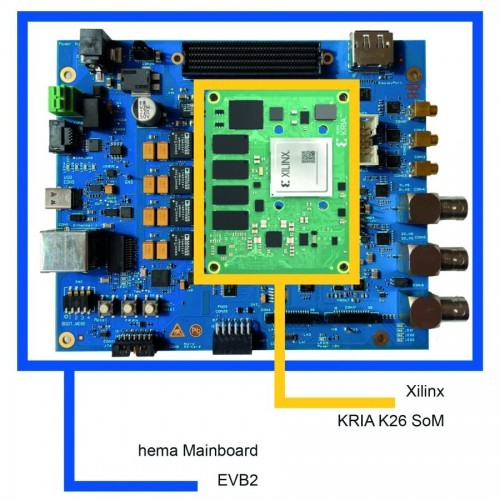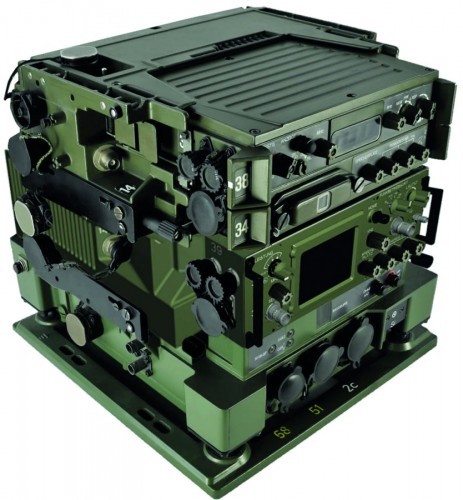The German armed forces are not alone in facing the problem that tried and tested analog technology cannot simply be replaced. A similar situation can also be observed in the transport infrastructure and in signal data processing applications. Here, the course can be set for a digital future - through embedded technology and modular electronics design.
The call for rapid digitalization can hardly be ignored and the advantages of digital data now predominate in all sectors and applications. Nevertheless, the costs and effort involved in replacing analog systems for signal data processing in traffic applications, logistics and monitoring are enormous. Retrofit solutions that expand analog systems without having to replace the entire infrastructure provide a remedy. With a modular electronic design, they are economical to implement and can be adapted to different applications.
Older camera systems and sensors that generate and transmit analog data, for example to a monitor, are still frequently used, particularly in large infrastructure projects such as railroad systems, for monitoring tunnels or access control of factory premises. These systems often work reliably. However, due to their age and the technological progress made since their introduction, their range of functions is usually very limited. In addition, in the event of a defect, discontinued modules cannot be replaced or can only be replaced at considerable expense.
Retrofit: using analog and digital together
 The new embedded vision platform from hema for Xilinx KRIA K26 SoMs is ideal for computing-intensive applications with different signal dataAnideal solution for modernizing such systems is retrofit electronics, which expand and enhance existing analogue systems with the possibilities of digital data processing. The analogue signal data is digitized and processed with modern FPGAs or ARM processors. Multiple signal inputs and outputs allow analog and digital data to be combined and, depending on the desired further processing, also shown as analog data on a display, for example, or output digitally. This means that even previously analog systems benefit from the more flexible processing options, faster data transmission without loss of quality and unlimited usage and storage time. At the same time, all interfaces of the existing system are supported so that the electronics can be perfectly integrated into existing systems. Defective assemblies can be replaced with more modern components with little effort and the infrastructure can be continuously modernized. A complete system change, which is associated with high effort, costs and risks, is not necessary.
The new embedded vision platform from hema for Xilinx KRIA K26 SoMs is ideal for computing-intensive applications with different signal dataAnideal solution for modernizing such systems is retrofit electronics, which expand and enhance existing analogue systems with the possibilities of digital data processing. The analogue signal data is digitized and processed with modern FPGAs or ARM processors. Multiple signal inputs and outputs allow analog and digital data to be combined and, depending on the desired further processing, also shown as analog data on a display, for example, or output digitally. This means that even previously analog systems benefit from the more flexible processing options, faster data transmission without loss of quality and unlimited usage and storage time. At the same time, all interfaces of the existing system are supported so that the electronics can be perfectly integrated into existing systems. Defective assemblies can be replaced with more modern components with little effort and the infrastructure can be continuously modernized. A complete system change, which is associated with high effort, costs and risks, is not necessary.
Upgrading through low latency and image processing
Once the data from the analogue sensors has been digitized, all the advantages of digital processing can be used, above all low latency processing with response times of less than 35 ms. In addition, new image processing functions are available, such as color graphic overlays, picture-in-picture displays or video multiplexing, in which several color camera images are combined into a single data stream. FPGA modules or ARM processors are used for command control of the functions. Both technologies can also be combined and combine high computing power and fast data processing with low series costs for the electronics.
Modular design reduces effort and costs
For the cost-effective development of electronics for collecting, processing and outputting analog and digital signal data, hema electronic has developed a modular construction kit, the hema Embedded Vision Platform. It includes hardware and middleware as well as a software framework, so that users receive a ready-to-use solution in the shortest possible time. To get started with development, they select the required interfaces and functionalities; over 45 building blocks are already available for selection in a library of ready-made circuit components, which is constantly being expanded. In contrast to a completely new development, customers benefit from circuit components that have been tried and tested in the industry and a significant time and cost advantage in development. This also effectively reduces the design risk. New functions or customer-specific circuit components can still be easily integrated.
SoMs deliver scalable computing power
The required computing power of the data distribution units is provided by System on Modules. They are available with FPGAs and ARM processors or a combination of both technologies and also include the memory and other EMC-critical components. The modular design reduces the complexity of developing the electronics - saving time and costs here too. The interface of the modules is standardized so that upgrades or different product variants are often possible without a complete redesign of the hardware. hema has been working with SoMs from Xilinx and Enclustra in numerous customer projects and for many years. Just recently, hema presented a new version of the embedded vision platform. It is the basis for the world's first industrial-grade mainboards with the new KRIA K26 SoMs from Xilinx, which combine enormous computing power and AI capabilities with a robust design.
A retrofit solution in six weeks
With hema's embedded vision platform, retrofit electronics for existing applications can be developed in just six weeks - from order to near-series prototype. In doing so, hema already takes the availability and life cycle of the intended components into account in the design and also supports its customers in all further development steps up to series qualification, including certification and approval. On request, the company can also take over lifecycle management and ensure the early replacement of components that are difficult or impossible to supply. Customers benefit from over 40 years of expertise in electronics development and production as well as many successful projects in traffic and security technology, transport and logistics, defense and medical technology.
Radio from the 80s
 The replica of the SEM 80/90 is a 1:1 copy of the original device on the outside. However, according to the BAAINBw, the functions on the inside were replicated using softwareWhenit was announced in summer 2021 that the Bundeswehr Procurement Office had purchased 30,000 analog SEM 80/90 radios from the French Thales Group allegedly 1:1 at a unit price of €20,000 in order to bridge the delays in the development of the 'Digitalization of Land-Based Operations' (D-LBO) project, the uproar was great and the procurers and administrators of defence technology in the Koblenz authority, correctly named the Federal Office of Bundeswehr Equipment, Information Technology and In-Service Support (BAAINBw), were accused of being from the day before yesterday or even not quite in their right mind. I could now join the chorus of blasphemers: The IT-Amt Bw, which has since been integrated into the BAAINBw, seems to have missed the point that reliable electronics don't necessarily have to have components with legs - but I don't even like to imagine what the logo would look like if it was based on current AVT trends.
The replica of the SEM 80/90 is a 1:1 copy of the original device on the outside. However, according to the BAAINBw, the functions on the inside were replicated using softwareWhenit was announced in summer 2021 that the Bundeswehr Procurement Office had purchased 30,000 analog SEM 80/90 radios from the French Thales Group allegedly 1:1 at a unit price of €20,000 in order to bridge the delays in the development of the 'Digitalization of Land-Based Operations' (D-LBO) project, the uproar was great and the procurers and administrators of defence technology in the Koblenz authority, correctly named the Federal Office of Bundeswehr Equipment, Information Technology and In-Service Support (BAAINBw), were accused of being from the day before yesterday or even not quite in their right mind. I could now join the chorus of blasphemers: The IT-Amt Bw, which has since been integrated into the BAAINBw, seems to have missed the point that reliable electronics don't necessarily have to have components with legs - but I don't even like to imagine what the logo would look like if it was based on current AVT trends.
However, any blasphemy is inappropriate in the case of analog radios: if they had dared to take an intermediate step, they would have stumbled over current procurement regulations and triggered an avalanche - both in terms of time and money. Because there would have been no getting around an official invitation to tender with corresponding deadlines. The total costs of €600 million estimated for the production contract with the French successor to the original SEM 80/90 manufacturer Standard Elektrik Lorenz are a reliable and predictable figure that should not get out of hand.
In addition, the Bundeswehr has apparently found a way to modernize a little while retaining the existing radio technology. This is suggested by a BAAINBw press release from late fall: "The intended solution with new, software-based radios offers the troops all previous capabilities in a cost-efficient manner, as it essentially draws on state-of-the-art technology," says the responsible project manager at BAAINBw. So behind the retained external form, which does not require any complex modifications to the vehicles and can be installed 'plug and play', there appears to be something hidden that only pretends to be a 1:1 replica of the radio equipment used by the troops since the 1980s. The SEM 80/90 is mainly used in land forces vehicles for tactical communications.
At the same time, the Bundeswehr is continuing to pursue the goal of "fully digitizing troop radio in the long term." Until this extensive project is fully implemented, the current agreement ensures the troops' continuous operational readiness. The use of the radios is planned until 2035.
By then, the results of the D-LBO and TEN (Tactical Edge networking) projects should gradually be introduced. According to project participants, the use of new technologies such as edge computing, cloud, mesh networks and artificial intelligence (AI) will increasingly determine information, command and control superiority during a military operation. AI-based information systems should then enable more informed, more precise and faster decisions through faster analysis of countless data from various sources. Cloud and edge computing as well as modern transmission technologies will help to distribute information optimally even with limited connectivity. We will see whether another large number of SEM 80/90s will need to be reordered in 2035.
the embedded vision expert
hema electronic has established itself as a development service provider to the electronics industry for hardware and software design for embedded vision boards and for industrial automation, defense and security technology systems. The complete range of services from a single source extends from consulting and conception to design (FPGAs, DSPs, embedded processors), qualification, rapid prototyping and small series production through to lifecycle management.


